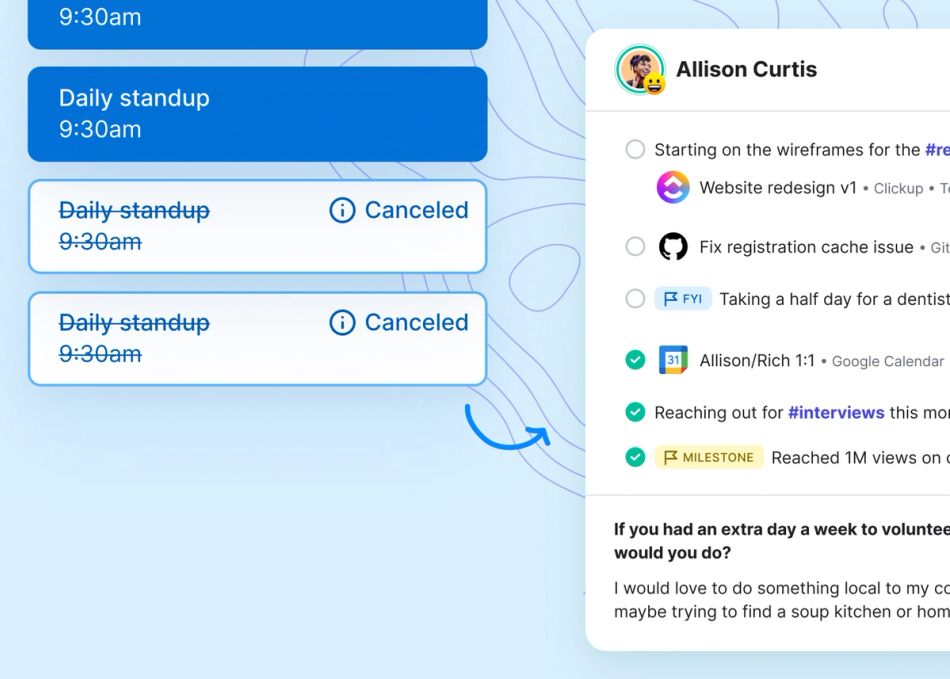
Are you getting the support you need as an eng manager?
According to research from Gallup, manager burnout is on the rise. Maybe you’re stretched too thin, or juggling leadership across a remote or hybrid team and struggling to keep everyone aligned.
The role of manager is never easy. Whatever your current roadblock may be, we think it’s about time the manager’s out there got some extra support too—so this article’s for you.
We spoke with 8 experienced engineering leaders and asked them the share nuggets of leadership advice during our video and podcast series, Lead Time Chats.
✅ Get new insights on managing teams and improving as a leader every week.
🚀 Join the Lead Time Newsletter
Their responses cover everything from meetings to processes to strategy, and some of them might surprise you.
You'll take away clear tactics and small shifts you can make today to empower your team, crush your goals, build a better product, and become a stronger leader.
1. Protect focus time at all costs
Engineering is creative work—which requires big chunks of protected time for focus.
With today’s meeting overload culture though, focus time quickly gets whittled away into nothingness at the expense of your team’s productivity, well-being, and sanity.
That’s why engineering managers need to take minimal meeting culture seriously.
“I’ve been making a conscious effort to minimize meetings, and so have the leaders who report to me. I don't want any IC engineers to be in operational meetings or ones that require giving status updates. Their calendar should be free to empower them to write good code.” — Sumeet Arora, Chief Development Officer at Thoughtspot
As a manager, think about the meetings on your calendar that could actually happen asynchronously instead—it’s probably more than you’d expect.
Things like status updates, stand-ups, and round robins at the beginning of a team meeting actually tend to be most effective when they happen async, using tools like Range Check-ins for engineers.

Reducing meeting dependency through async communication helps free up more of your team’s time to focus on what they do and also helps you keep a clear, well-documented line of sight on in-flight work.
2. Slow down to move fast
As an engineering manager, one of your biggest roles is to help your team move from point A to point B faster. Pretty simple, right?
Not always. It may sound counterintuitive, but sometimes slowing down can be the best way to help your team speed up.
“Slow is smooth, and smooth is fast. I see so many inefficiencies in engineering, and almost none of them have to do with how hard the engineers work. Building the wrong thing — that’s really expensive and takes a ton of time.” — Kate Heddleston, Senior Engineering Manager, Samsara
To increase your engineering team’s velocity, experienced leaders recommend leaning into two levers: clarity and focus.
When you’re solely trying to achieve speed, teammates often end up with nebulous tasks and competing requirements. Taking a pause to create clear goals and clarity around what you’re building actually helps engineering teams work more efficiently—and therefore faster. Honing your focus to a few key projects at a time also helps speed up work. Scoping for less is always faster than trying to do it all.
Learn more about speed in engineering.
3. Consider the system, not just the parts
Approaching engineering management through a systems-thinking perspective can be hugely beneficial. As a leader, your system is your team environment—the conditions, processes, values, and norms your team operates within on a regular basis.
“I always go back to Grace Hopper, who said: ‘You don't manage people: you manage things, you lead people.’ What does that mean for engineering managers? It means you don’t have to focus on telling people what to work on that day—you’re already working with brilliant people. Instead focus on: Do people know what's most important as a team? Do they know how to help each other?” — Pat Kua, Founder of Tech Lead Academy
When it comes to things like changing team behavior or correcting a project that’s gone off-course, focusing on the system is key too. Is your team incentivized in a way that motivates them? Are their gaps or silos within the team’s flow? Each of these environmental factors can have a tremendous impact on individual work and understanding them can help you unlock greater team well-being and results.
Learn more about systems-thinking in tech leadership.
4. Focus on “team experiments” over process changes
Ever try to add a new meeting or process to the mix only to be met with resistance and skepticism? You’re not alone. As teams grow, meetings and processes need to evolve along with them, but process mandates are an easy way to spawn frustration and disengagement.
To counter this, try framing process adjustments as a team-wide effort through experimentation.
Instead of "process changes" I talk about "team experiments." Framing things as experiments is an equalizer. It gives the suggestion that you, as a manager, don’t have all the answers and that nothing is set in stone. It’s an invitation to everyone on the team to participate.” — Cate Huston, Engineering Director at DuckDuckGo
Experimenting with team processes also improves buy-in around it. Presenting an idea as an experiment (instead of a top-down mandate) makes it feel more flexible and lightweight. Team members are then more willing to give it a try, provide feedback, and iterate on something that actually sticks. more likely to give something new a try.
5. Invest your time in learning about the business
Most engineering managers are engineers themselves, and therefore have a tendency to stick close to the code when it comes to leadership. Though it may be where your expertise lies, it’s not necessarily the most impactful way to lead your team.
Thinking beyond technical decisions and expanding your purview to the broader business gives your team a seat at the table, and allows you to set clear, achievable goals that map to the bigger picture.
“One of the most illuminating moments for me was when I started having the language: cost of acquisition, lifetime value, cohort. I started spending the same amount of time learning about business growth as I did reading about JavaScript frameworks—and it gave me superpowers. Suddenly I was part of the business. I got invited to places I wasn’t getting invited before to represent engineering.” — Juan Pablo Buriticá, most recently Head of LatAm Engineering at Stripe
6. Make ownership and decision making crystal clear
Projects tend to stall when there isn’t a clear decision-making structure in place to problem-solve and move ahead quickly. This one’s especially important if you’re leading a remote or hybrid engineering team.
“Especially for technical roles like engineering, there needs to be a clear process for technical and even non-technical decision making. Do you have an inclusive process where, regardless of if someone is remote or in-person, they have equal opportunity and say in a process of decision-making?” — Ellen Wong, Director of Engineering at Calm
Creating a decision-tree or other type of documentation is a great starting point. For more clarity around ownership in decisions, many teams use the RACI framework.
RACI’s an acronym that stands for: responsible, accountable, consulted, and informed.
Learn more from Ellen on managing remote and hybrid teams.
7. Get clear on how you support junior and senior engineers
Figuring out how you can work effectively with different folks on your team is table stakes when it comes to good engineering management. But your definition of “work effectively” will look different from teammate to teammate.
For more junior team members, your relationship might be more about mentorship and coaching. For more senior folks, it’s about finding different ways to offer support.
"The first thing that I recognize with my very senior people is that I'm not really going to teach them anything. But I can provide a different perspective and context on things. I can give the 10,000 foot view, so they can focus on the things that matter more to them. I can unblock them. I can give them feedback on things like communication or work style, or just provide insight that they're not seeing on their own. It’s less about technical seniority, more about being there to support.” -- Tess Rinearson, VP of Engineering at Interchain
8. Get intentional with your toolkit
Let’s face it—your team management tools either greatly speed up you or slow you down. As an engineering manager, streamlining your team’s workflow means less time tracking down updates and reporting on work, and more time getting sh*t done.
We’re seeing more and more eng leaders turn to Range for team communication, because it connects all their existing tools, workflows, meetings, and sub-teams in one place.
See all of the Range integrations.
“As a manager, Check-ins really helped me do away with all the weekly status reports in email. And with the meeting function, it’s become so much easier to create an agenda. We’re constantly actioning things.” — Kristin Toole, Content Experiences & Innovation Team Lead at Adobe
Manage your team more effectively with Range
Being a manager is hard work. A lot depends on you and your ability to set your team up for success. When you get it right though, it’s extremely rewarding.
Range helps managers get it right more often.
In Range, engineering managers can track their team’s meeting and workload over time, and spot trends and ways to boost focus time and wellbeing.
See what Range can do for engineering teams.
Range makes it easy to set focused goals for your team and track daily progress towards them.
For managers, it’s also a streamlined way to keep a pulse on your team’s day-to-day so you have more time to focus on the bigger picture. You’ll always know who’s working on what and project updates are clearly documented to learn and grow from over time.








